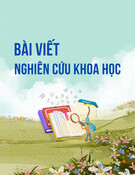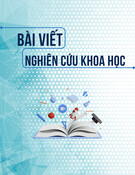
10
HNUE JOURNAL OF SCIENCE
Social Sciences 2024, Volume 69, Issue 4, pp. 10-17
This paper is available online at https://hnuejs.edu.vn/
DOI: 10.18173/2354-1067.2024-0063
A COMPARATIVE ANALYSIS OF VIETNAMESE TRANSLATIONS
OF THE OLD MAN AND THE SEA BY ERNEST HEMINGWAY
Vu Hong Mai Phuong* and Do Van Hieu
Faculty of Literature, Hanoi National University of Education. Vietnam
*Corresponding author: Vu Hong Mai Phuong, e-mail: vuphuong30092003@gmail.com
Received October 14, 2024. Revised November 8, 2024. Accepted November 12, 2024.
Abstract. Literary translation plays a significant role in the development of any literary
tradition. Translation Studies, in the case of The Old Man and the Sea by Ernest Hemingway,
uses a comparative approach to analyze and interpret the similarities and differences between
various translations, then clarify the translation strategies of contemporary translators. This
comparison aims to highlight the role of internal and external textual factors in translation
that affect the readers' reception process.
Keywords: literary translation, The Old Man and the Sea, Ernest Hemingway.
1. Introduction
Ernest Hemingway is a renowned figure in American literature. He first worked as a
journalist before devoting himself entirely to writing some books like The Sun Also Rises (1926),
A Farewell to Arms (1929), For Whom the Bell Tolls (1940), etc. Nevertheless, only after the
release of The Old Man and the Sea in 1952, he achieved enormous success and numerous awards,
most noticeably the Pulitzer Prize in 1953, and the Nobel Prize in Literature in 1954. It took only
two years (1956) for this work to be quickly published in Southern Vietnam. After meticulous
research, there have been nine Vietnamese translations of The Old Man and the Sea:
1. Ông lão và biển cả (1956) - translated by Mac Do (Quan Diem Publishing House, Saigon)
2. Ông già và biển cả (1962) - translated by Huy Phuong (World Publishing House, Hanoi)
3. Ngư ông và biển cả (1967) - translated by Bao Son (Ngay Nay Publishing House, Saigon)
4. Ngư ông và biển cả (1973) - translated by Mac Mac (Saigon)
5. Ông già và biển cả (1999) - translated by Nguy Mong Huyen (Hanoi)
6. Ông già và biển cả (1999) - translated by Le Huy Bac (Van Hoc Publishing House, Hanoi)
7. Ông già và biển cả (2017) - translated by Dam Hung (My Thuat Publishing House, Hanoi)
8. Ông già và biển cả (2024) - translated by Hien Trang (Van Hoc Publishing House).
These statistics are synthesized from the researcher’s document collection process, gleaned
from the introduction by Le Huy Bac (the translator of The Old Man and the Sea), and the data
collected by Bui Thi Kim Hanh in her Master’s Thesis (Translating Issues in Hemingway’s ‘The
Old Man and the Sea’ in Vietnam, 1998) [1] and Doctoral Thesis (Hemingway in Vietnam, 2002)
[2] in Hanoi National University of Education. Four remaining texts have been identified and
translated by Mac Do, Huy Phuong, Le Huy Bac, and Hien Trang. Additionally, most previous
research about this artwork through translation approaches, including the above, mainly focuses

A comparative analysis of Vietnamese translations of The Old Man and the Sea by Ernest Hemingway
11
on the linguistic aspects but not the cultural, social, or political ones, owing to the lack of theories
that have been translated or appeared in Vietnam.
Translation Studies, especially Translation Theories, has a long history. Translation, firstly,
is the process of converting from one language to another or shifting the cultural boundaries, and
social and political backgrounds among regions, areas, and countries. It should also be considered
“a transmission of ideas, concepts, structures, or even literary movements from one form to
another” [88; 4]. Even before this discipline's emergence, there were a variety of translation
debates mainly based on the experience of translating religious texts in the West. These debates
often centered around “faith” and “freedom”, “word for word/ literal” translation (following so
closely the form of the source text), and “sense for sense/ free” translation (allowing the sense or
content of the source text to be translated) [5]. In the Orient – a similar discussion took place by
looking at Yan Fu’s three criteria for translation: “Faithfulness – Expressiveness – Elegance” (Tín
– Đạt – Nhã) [6]. In response to the growing demand for literary translation, a plethora of essays
suddenly increased in the early 20th century before the linguistic approaches in the 1950s (e.g.
Eugene Nida, Catford) with the development of concepts such as “formal equivalence,” “dynamic
equivalence,” and “functional equivalence,” which focus on the equivalent effect of messages,
expressions or process between the source text and the target text [7, 8]. In the 1990s, the “cultural
turn” brought new methods into translation practice that considerably altered most literary
scholars” mindset at that time. These include “domestication/ familiarised” (bringing the original
work closer to the target audience) and “foreignization” (bringing the target audience closer to
the original work) [9]. Another significant approach that emerged in the late 1990s and early
2000s was Postcolonial Translation Theory, which primarily challenges the ‘Westernization’
strategies in translated texts [10]. Additionally, Interdisciplinary Studies gained prominence by
incorporating political, social, and gender perspectives into the theoretical translation studies.
Hence, in the bigger picture, Translation Studies can surpass the debates between ‘literal and
‘free’ translation, the conception of “les belles infidèles” (the unfaithful beauties). It can also
explore the translator’s fidelity to expand the scope of historical phenomenons, or cultural,
political, and social change.
After a brief overview of the translation strategies of Mac Do and Huy Phuong, this study
underscores the similarities and difficulties through linguistic and cultural approaches between
the two most widespread Vietnamese translations, by Le Huy Bac and Hien Trang. There are also
two expert interviews conducted about the translation or publishing process of Vietnamese
translations of The Old Man and the Sea, one with Hien Trang (22/03/2024), and another with Le
Huy Bac (16/04/2024). Therefore, based on their translations and interviews, it brings a
comparative analysis to interpret their translation strategies and then highlights the role of internal
and external textual factors that affect the readers’ reception process nowadays through political,
social, and economic aspects or even the translators’ background.
2. Content
2.1. Research on the Translation Strategies of Mac Do and Huy Phuong
The Vietnamese translation by Mac Do (Saigon, 1956) – Ông lão và biển cả – is based on
the original English version of Hemingway; however, it adopts a relatively free style which is one
of the characteristics of the early period of Vietnamese literary translation. He paid special
attention to lexical fields related to fishing but did not always name them accurately in
Vietnamese, or even left them untranslated (marlin, bonito). He constantly split long sentences
into 2 to 4 shorter ones and added words, phrases, or punctuation marks to express emotions or
simply shorten them (E.g. “Eat them, fish. Eat them. Please eat them” – 3 sentences is translated
as “Rỉa đi, rỉa đi chú mày!” – 1 sentence [11]).

Vu HMP* & Do VH
12
Huy Phuong’s translation, on the other hand, took a different approach by using the intermediary
French translation Le Vieil Homme et la Mer by Jean Dutourd), and sometimes referred to the
Chinese one. As a result, the translation involved at least two layers: the first one is languages,
culture, and artwork’s background, and the other is the translators’ explication. J. Dutourd, who
viewed this work as a fairytale story, began the French translation by transforming Hemingway’s
opening “He was an old man” into “Il était une fois” (Once Upon a Time) – a common beginning
of fairytale motifs [12]. He expressed his opinions by choosing proper words and breaking a long
original sentence into 2-4 short, concise, and simple French ones that convey the fairytale sense.
Through J. Dutourd’s translation, Huy Phuong also translated precisely according to the split
sentences [13], especially, “added adjectives, adverbs, or implied parts that Hemingway intended
to leave untold” [1]. The Vietnamese translator also appears to consider the old man’s fishing in
the original work as the Southern people’s one in Vietnam, which Vietnamizes this context with
labor songs (with the beginning motif “Dô ta”/ Let’s go), or translating proper nouns like “Nữu
Ước” (New York), “khách sạn Vọng Lâu” (Terrace), “Xăngchiago” (Santiago), “Manôlin”
(Manolin), etc. The reason that is ‘Huy Phuong's translation of elegance is the best’ in the
Vietnamese translation of The Old Man and the Sea before 1975 [3] because not only it was
influenced by the interpretation of the French translation, but also he believes that “many
important issues about life and human fate in a society still inhabited by impoverished and solitary
fishermen like Santiago” [14]. It shows that Huy Phuong explicated the old man's hardship in the
marlin fishing process as a consequence of poverty and loneliness, rather than emphasizing the
modern existential struggle, where individuals, despite recognizing the inherent limitations of
certain endeavors, persist in their fight.
Both translators translated quite freely (splitting long sentences, adding expression words,
and punctuation marks), and “Vietnamized” Hemingway’s work to overcome linguistic and
cultural barriers. These translations, consequently, show a noticeable divergence from the original
text. Huy Phuong’s translation (published in Northern Vietnam) – not the translation of Mac Do,
Bao Son (published in Southern Vietnam) – was widely taught in high school literature textbooks
in the 1990s, although it was the only one that used the French translation (not the original one)
[1]. This shows that Southern-translated literature (1945-1975) always requires literary scholars
to re-evaluate its contribution to Vietnamese (translated) literature.
2.2. Research on the Translation Strategies of Le Huy Bac and Hien Trang
2.1.1. A Comparative Analysis of Translations by Le Huy Bac and Hien Trang
When comparing the translations by Le Huy Bac and Hien Trang, one of the noticeable
features to differentiate them is how they handled pronouns. Because Vietnamese is fairly flexible
with personal pronouns, it can convey a wide range of nuances. In the phrase “the old man”, is
translated as “ông già” in the title while both translators called it “lão” throughout the texts. It not
only reflects his age but also conveys a colloquial tone, close to working-class people. However,
in the monologue between the old man and the marlin using I/me and he/him, Le Huy Bac used
the pronouns “ta” – “ngươi” (“tao” – “mày”), while Hien Trang translated them as “ta” – “hắn”
(“ta” – “ngươi”). In our evaluation, Trang” 's translation is closer to the original text and captures
the old man’s respectful attitude towards the marlin as an adversary and a noble creature: “Hắn
là người anh em của ta. Nhưng ta phải giết hắn và tiếp tục mạnh mẽ để làm được điều đó” (“He
is my brother. But I must kill him and keep strong to do it”).
The translations by Le Huy Bac and Hien Trang could accurately capture the lexical fields
related to fishing, which the translations before the 1975s could not, including fishing operations,
fishing tools (coiled lines/ sào săn, gaff/ lao móc, harpoon/ cánh buồm, etc.), or various types of
fish (sardine/ cá mòi, dolphin/ cá dorado/ cá heo, etc.) in the Gulf Stream. Both translators decided
to keep the name of characters and locations in the original form like “Manolin”, “DiMaggio”,

A comparative analysis of Vietnamese translations of The Old Man and the Sea by Ernest Hemingway
13
Terrace), or Spanish (non-English) words like “Que va”, “agua mala”, and “bodega”, which
reflects the translators” deep awareness of the original work with “foreignization” strategies. Hien
Trang, on the other hand, tends to “domesticate” some foreign factors by generating Vietnamese
idioms to bridge the linguistic and cultural gap. For example, when predicting the fish’s actions,
the old man thought, “If you said a good thing it might not happen”. While Le Huy Bac literally
translates as “Nếu người ta nói ra điều gì tốt lành thì nó sẽ không xảy ra”, Trang used an idiom
“nói trước bước không qua” that can carry a familiar sense for Vietnamese readers. There are a
variety of translation strategies, where “linguistic features related to the source culture (such as
dialect or unfamiliar lexical items) can be underlined as defamiliarized elements in the text, or be
domesticated in some way, or be circumvented altogether” [21; 15].
Another difference between these two translations is in how Le Huy Bac and Hien Trang
handle the telegram style in Hemingway's writing from his previous journalism experience. Le
Huy Bac’s translation aligns more closely with the Iceberg Theory of Hemingway with
approximately the same word count. Furthermore, Ernest Hemingway often employs declarative
sentences, which are simple but implicit, and a high frequency of conjunctions “and” that are not
familiar to Vietnamese writing. Le Huy Bac translated them with short sentences in a calm but
assertive tone, and replaced “and” with some punctuation marks, while Hien Trang maintained
all, and even added some conjunctions (có lẽ, và, hơn nữa, với) [16]. Trang’s strategies,
consequently, sometimes slightly lose the connection between Vietnamese words and sentences
within the paragraph, thus failing to capture Hemingway’s style and nature’s vitality in The Old
Man and the Sea.
* Original text: He came out unendingly and water poured from his sides. He was bright in
the sun and his head and back were dark purple and in the sun the stripes on his sides showed
wide and a light lavender. His sword was as long as a baseball bat and tapered like a rapier and
he rose his full length from the water and then re-entered it, smoothly, like a diver and the old
man saw the great scythe-blade of his tail go under and the line commenced to race out.
* Le Huy Bac’s translation: Nó nhô lên bất tận, nước đổ ròng ròng từ hai bên lườn. Thân
hình bóng nhẫy trong ánh nắng; đầu và lưng màu tím sẫm; trong ánh nắng, những đường sọc hai
bên mình nó nom đồ sộ, phớt hồng. Cái kiếm của nó dài bằng cây gậy bóng chày, thon như một
lưỡi kiếm; nó vươn hết độ dài thân hình lên khỏi mặt nước rồi nhẹ nhàng lao xuống như một tay
thợ lặn; ông lão nom thấy cái đuôi hình lưỡi hái đồ sộ chìm xuống và sợi dây câu lại hút theo.
* Hien Trang’s translation: Nó không ngừng nổi lên và nước trút xuống từ hai bên sườn
của nó. Nó sáng chói dưới ánh mặt trời, và cái đầu, cái lưng của nó mang màu tím thẫm, và dưới
ánh dương, những vạch kẻ sọc bên sườn nó hiện ra rộng bản và phơn phớt màu oải hương. Cái
kiếm của nó dài như một cây gậy bóng chày và thuôn như thanh kiếm mảnh, từ dưới nước nó trồi
lên toàn bộ chiều dài cơ thể và rồi lại lặn xuống, một cách uyển chuyển, y hệt một tay thợ lặn, và
lão thấy được cái lưỡi hái vĩ đại nơi chiếc đuôi của nó lặn xuống, sợi dây câu bắt đầu lao theo.
In this example, Le Huy Bac recreates Hemingway’s style by employing strong verbs and
adjectives such as “nhô lên bất tận” (“came out unendingly”), “đổ ròng ròng” (“poured”), “bóng
nhẫy” (“bright”), and using commas to separate clauses instead of conjunctions. Sometimes, while
he opted to use inversion to make the Vietnamese sentences more flexible (e.g. “The boy and I
will splice them when we are home” – “Thằng bé sẽ cùng mình nối lại khi về đến nhà”), Hien
Trang adopts a more literal approach, aiming to closely align the sentence structures of English
and Vietnamese (e.g. “Thằng nhóc và mình sẽ nối chúng lại khi ta về đến nhà). Both translators,
during expert interviews, acknowledged the distinction between the author's style and
conventional English writing style [17, 18]. This difference, however, was variously addressed,
depending on each translator's experience and interpretive skills throughout the translation
process. In general, Le Huy Bac’s translation demonstrates the foreignization strategy at that time,
while Hien Trang’s version tends to incline more towards domestication. Her translation appears

Vu HMP* & Do VH
14
to disrupt the conciseness in the monologues and dialogues of the old man with himself, Manolin,
or even the marlin. Although these strategies make this version more easily comprehensible to
the public reader, she cannot fully capture the stylistic features of Hemingway’s works and the
hidden iceberg technique.
2.1.2. An Interpretation of Translation Strategies of Le Huy Bac and Hien Trang
We argue the differences between these two translations due to two main reasons. Firstly,
how the translation strategies of Le Huy Bac and Hien Trang reflect their perspectives they
approached the original work because their viewpoints directly determine their rendering in the
translation process. Le Huy Bac, in an interview, assumed that “to translate the old man’s work
and feeling, we have to role-play and imagine how he fished, how he talked, how he thought”
[19]. This immersive approach, through role-playing and imagination, gave him a deeper
connection with the protagonist’s mindset to interpret the original work as a reader and a
translator. Hence, he not only translated the text accurately but also captured the essence of
Hemingway’s style. Hien Trang, in the expert interview, assumed that she explicated The Old
Man and the Sea from the young boy Manolin’s perspective – “a child observing the old man
whom he always admires and respects” while representing the younger generation’s view of
classic works [18].
The professional backgrounds of both translators directly relate to literature-researching and
writing, a considerable advantage in handling this work. As a professor who specializes in
American literature with a profound understanding of American literary context, Le Huy Bac
demonstrates impressive analytical skills in researching The Old Man and the Sea from various
perspectives, including a close study of the original work itself and an exploration of its
intertextuality, reflecting its relation with other texts. On the other hand, Hien Trang, as an author,
should be examined through the interaction between her creative process as a writer and her
recreation as a translator. Her latest work, Quán bar trong bụng cá voi (2024), may influence her
Hemingway’s short story translation. According to Trang, she prepared to translate The Old Man
and the Sea with complete respect and no restriction from the publisher right after finishing Quán
bar trong bụng cá voi. This novel, as a result, marks the connections with her translation of
Hemingway’s work (2024) in the lexical fields related to fishing such as “shark”, “dolphin”,
“tuna”, “bonito”, “marlin” (cá mập, cá heo, cá ngừ, cá ngừ bonito, cá kiếm, etc.), or a rich
knowledge of American – English literature such as The Old Man and the Sea (Ernest
Hemingway), Ulysses (James Joyce), and Moby Dick (Herman Melville) [20]. There are a lot of
introspective passages where the protagonist’s personal thoughts are expressed, conveyed through
many conjunctions, long sentences, tons of consumptions, and comparisons in her latest book.
These intersections between the two works, as a writer and a translator, make her translation more
attractive.
As a result, Le Huy Bac did not simply “transform the text in a purely Vietnamese accent”
[19] but adhered closely to Hemingway’s grammatical structures and word choices. His
translation leaves a strong impression due to its timeless value, particularly in its profound
understanding of the original text, which surpasses the translation consciousness prevalent in
Vietnam in the late 1990s. As for Hien Trang’s text, she partly ‘domesticates’ Hemingway’s work
while remaining a certain openness in her explication of the original work. Literary translators
sometimes are willing to ignore some clarity or precision in expression to achieve the
‘foreignization’ strategy, which makes Vietnamese sentences more flexible. ‘Foreignization’, in
this way, does not mean the ambiguity in literary creation, but rather their attempt to keep the
original English structure and convey the author’s intent. Hence, to explore the literary afterlife,
we should research it in various forms, including its translation and the translation reader’s
reception, especially in notable artworks.


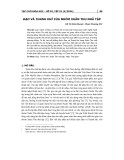


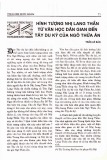
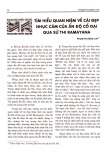
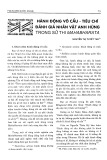
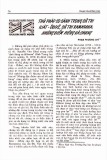
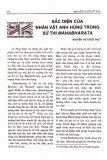
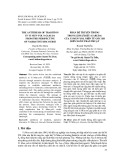
![Bộ câu hỏi trắc nghiệm Văn bản tiếng Việt [chuẩn nhất]](https://cdn.tailieu.vn/images/document/thumbnail/2025/20251127/thuynhung051106@gmail.com/135x160/24021764296609.jpg)
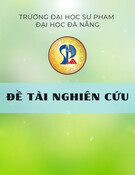

![Bài giảng Ngôn ngữ học đối chiếu Nguyễn Ngọc Chinh [PDF]](https://cdn.tailieu.vn/images/document/thumbnail/2025/20251101/vovu03/135x160/7471762139652.jpg)

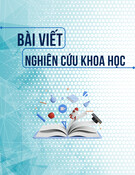
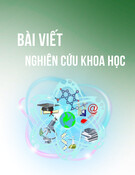
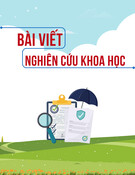
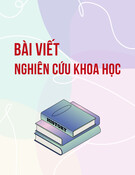
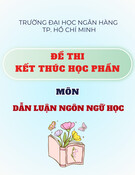
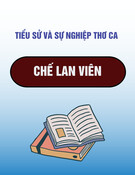
![Ngân hàng câu hỏi môn Tiếng Việt thực hành [chuẩn nhất]](https://cdn.tailieu.vn/images/document/thumbnail/2025/20251003/kimphuong1001/135x160/21861759464951.jpg)
![Bài giảng Văn học phương Tây và Mỹ Latinh [Tập hợp]](https://cdn.tailieu.vn/images/document/thumbnail/2025/20251003/kimphuong1001/135x160/31341759476045.jpg)
